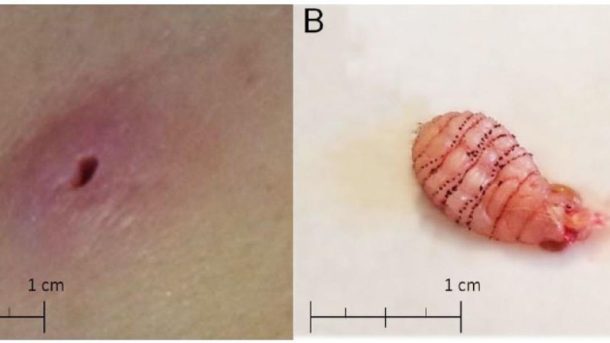A 36-year-old Florida woman made a shocking discovery after her honeymoon in Belize: she had a human botfly larva living under her skin.
When most people return from their honeymoon, they bring back souvenirs. Unfortunately, this woman brought home an unwelcome guest—a baby fly that had burrowed into her skin. The woman, whose identity remains private, initially had a smooth honeymoon in Belize, but two months after returning home, she noticed something unusual.
According to a case report published in the Journal of Investigative Medicine High Impact Case Reports, the woman discovered a pimple-like lesion on the left side of her groin. The itchy, but painless bump led her to believe it was an insect bite from her trip, so she visited her doctor. He suspected it was an infected spider bite and prescribed antibiotics, but the treatment had no effect.
Seeking a second opinion at a wound management clinic, doctors noticed the lesion had developed a central hole with pus. Dr. Enrico Camporesi, the lead author of the case report and a wound healing specialist at Memorial Hospital in Tampa, noticed something unusual about the wound—it felt hard, like something was embedded beneath the skin. The woman was then referred to a surgeon who suspected a foreign organism might be growing under her skin.
The surgeon’s suspicion was confirmed when they opened the lesion and found a human botfly larva.
So, what exactly is a human botfly larva, and how common are they? Human botflies (Dermatobia hominis) are large, hairy flies that resemble bumblebees. While the adult form is rarely seen, the larvae pose a problem for humans. The larvae infect humans through eggs transferred via mosquito or fly bites, leading to a condition known as myiasis. Myiasis is the fourth most common travel-related skin disease and is prevalent in tropical regions like Belize, though rarely encountered in the U.S.
Once the botfly eggs enter the human body, the warmth of the skin causes them to hatch into larvae, which can remain under the skin for 27 to 128 days. During this time, the larvae create painful pustules that release fluid, and the central hole in the wound serves as a breathing passage for the larva. Common infection sites include the genitals, scalp, breasts, and eyes. Some patients have even reported feeling the larvae move under the skin, especially when they shower or cover the wound.
While this situation sounds terrifying, botfly larvae are not known to transmit diseases, and most cases don’t require surgery—patients can usually remove the larvae themselves. If left alone, the larvae eventually exit the skin on their own. In regions like Belize, locals have home remedies to speed up the process, such as covering the wound with petroleum jelly, bacon strips, or nail polish to suffocate the larvae. However, surgical removal may still be necessary if the larvae burrow too deep.
Fortunately, the woman’s botfly larva was successfully removed, and her skin healed completely. Though human botfly infections are rare in the U.S., they are a known risk for travelers to tropical regions of the Americas.
Watch the video for more:
